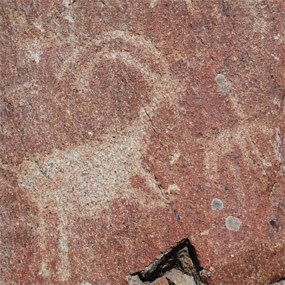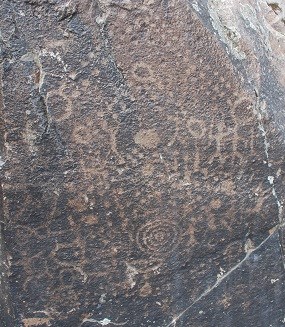|
Long before European immigrants first set foot in this country, the ancestors of the nimíipuu (Nez Perce) created densly grouped clusters of petroghlyphs and a few pictographs on either side of an eddy formed by a series of sharp bends in the Snake River. These images provide links to the past, reminding us of the timeless connection humans have to this land. Known as Buffalo Eddy, the site takes its name from images on the Idaho side of the river, depicting bison chased by Indians on horse back. The unique petroglyphs of this area are evidence of the longevity of the nimíipuu in the region and contain hundreds of distinct images that possibly date from as early as 4,500 years ago and continue to just a few hundred years ago. The fact that this site was used for so long suggests that it was very important to the people who lived here. 
National Park Service What is a Petroglyph?Petroglyphs are made by removing the outer weathered surface of rock to reveal the unweathered rock underneath. This is done by pecking, rubbing, scratching, or incising the surface with a harder rock, such as quartzite. There are several styles of petroglyphs at Buffalo Eddy. Some are naturalistic with human figures and animals such as bighorn sheep, elk, and deer. Some figures at the site appear to hold an item that looks like a dumbell. This may represent a double headed rattle or paddle. Groups of naturalistic animals and humans in a single panel may tell a story related to hunting, or may have had spiritual significance to the artist who carved them. Still others consist of abstract designs and patterns that include dots, circles and triangles. What is a Pictograph?Whereas petroglyphs are literally scratched into rock, pictographs are made by painting or drawing on the rock surface with pigments. These pigments were made from minerals that could be found in the area. The pigment was turned into something akin to paint by mixing the pigment with water, urine, blood, saliva, raw egg, or animal fat. These binders help the minerals adhere to the rock. The pigment was applied with fingers or a brush-type implement. Over time this pigment actually becomes a part of the rock. 
National Park Service Dating Rock ArtThe subject matter of rock art can often help determine a possible age. For example, the Nimiipuu obtained the horse around 1630, therefore pictograph panels containing horses were probably made after that date. Rock art showing an ancient hunting tool called an atlatl, which was used prior to the introduction of the bow and arrow, would suggest an age of at least 2,000 years. In some cases datable artifacts like an arrowhead found at the base of a partially buried rock art panel, can suggest a minimum date for the art. The petroglyphs that consist of abstract designs and patterns that include dots, circles and triangles, are considered to be the oldest at Buffalo Eddy. There have been many advances in research to date rock art through scientific analyses. Some petroglyphs can be dated based on an analysis of the weathered varnishes or patination that forms over rocks as they age. This method compares the varnish layers from the unpecked surface with the varnish of a pecked surface. Pictographs can be dated by testing very small samples of the pigment removed from the surface of the rock. Unfortunately, using either dating method damages the resource, so in most cases anthropologists prefer to approximate relative ages by comparing styles of petroglyphs across wide areas. 
National Park Service What Do These Images Mean?The petroglyphs and pictographs at Buffalo Eddy reflect a rich culture. Anthropologists who study rock art can often find patterns in the symbols that are found in the Columbia River Basin, and can make educated guesses on why symbols were painted or pecked into rock faces. Perhaps the figures and symbols are a form of storytelling or an expression of spirituality. They could even be a form of artistic expression. While scientists can make assumptions, ultimately no one but their creators know the exact significance of the images. We cannot hope to reconstruct the day of their creation. Was it done through a shaman's chants and intricate dance steps during an elaborate ceremony, or during a moment of introspection experienced by solitary visitors? All we have is the silent testimony of ancient images to pique our imaginaiton, and every person who sees them today takes away their own meanings. Respecting Sacred GroundThese ancient petroglyphs are sacred to the nimíipuu and protected by federal law. Although the art remains fairly well preserved, it takes only one senseless act of vandalism to destroy this fragile resource. The digging, collection, or damaging of these resources is a felony office punishable by fines up to $100,000 or imprisonment or both. Please help us protect and respect Buffalo Eddy by taking only photographs and leaving only footprints so that generations of visitors to come will be able to experience them.

Visit Buffalo Eddy
Plan your visit to a site that contains hundreds of unique petroglyphs that possibly date from as early as 4,500 years ago. |
Last updated: December 30, 2022
